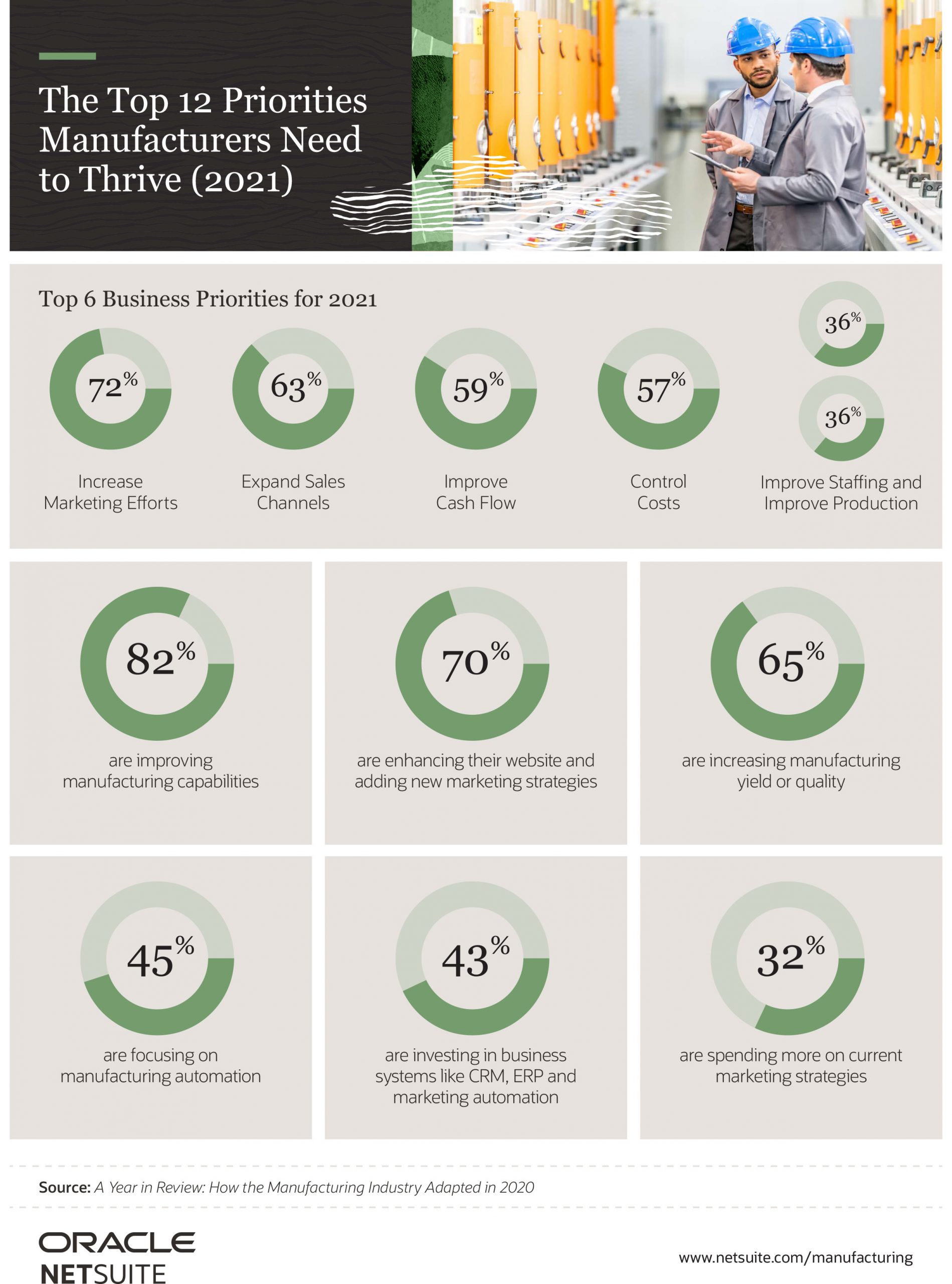There are many lessons to be learned from the events of last year, and much reason to be optimistic about a return to growth in 2021.
By: Ranga Bodla, Head of Industry Marketing, Oracle NetSuite
Already by the end of 2020 there were signs that conditions were improving, with a recent 2021 manufacturing industry outlook from Deloitte noting that industrial capacity utilization had improved by more than 10% by the end of 2020 versus earlier in the year. This report shows that while growth in 2021 will vary for manufactures based on how the challenges of 2020 impacted their business, there is a commitment to increasing agility in operations as a common imperative.
There are some other common themes to learn from last year as well, especially when it comes to managing supply chain, cash flow and marketing. These critical functions were fraught in 2020, but what can we take away to be more agile and adaptable as we look for a return to growth?
Unsurprisingly, in a recent Brainyard survey from Oracle NetSuite, we found that 88% of responding manufacturers had some degree of disruption to their business in 2020. Much of that disruption was caused by supply chain issues, but even with this more than 60% of those same respondents have a very or somewhat positive outlook in 2021. It is clear that the dependency on overseas suppliers was an immediate sore point for virtually all manufacturers last year. For some it remains a challenge, most especially when it comes to raw materials.
What is emerging however is the opportunity to diversify and shift suppliers, especially to be more domestically focused. As Deloitte notes, this creates an opportunity for manufacturers to evaluate “where and when to recalibrate their global production footprint” as well. This in turn provides a chance to add more agility to this particular operational aspect by evaluating new supply chain partners as well as supply chain management within your organization.
Taking this time to evaluate new partners and gain new operational insights not only ensures things run as smoothly as possible under the circumstances, but also means organizations will be better prepared when the next disruption arises. This ability to keep an agile supply chain then becomes paramount to not only organizational efficiencies, but to maintaining another critical business function – cash flow.
In the same NetSuite survey, more than three quarters of respondents noted a hit to their cash flow: primarily due to delayed orders and overall reduced sales. Cash flow remains a primary source of concern even in 2021, with 64% of respondents expecting cash flow issues. The data is hardly surprising as much as it highlights that the return to growth won’t just happen with the flick of a switch.
Perhaps the biggest takeaway here is the ever-increasing role insights and data must play in manufacturing today. Without having the software and technology in place to provide real-time insights into your operations and cash flow, it is not too dramatic to equate this to trying to fly a plane while blind. Technically you may be able to do it, at least for a little while, but in the long run you’re going to run into some serious issues. Having real-time data quickly available keeps your business agile. You can see what is and isn’t working, allowing you to identify how best to protect your organizations cash flow, while maintaining costs and investments.
Disruptions and challenges aside, there is still a need to look forward towards growth and with that comes calculated marketing investments to weather the storm. Many manufactures are looking at new ways to expand their businesses for growth this year, and with that new marketing spend. It makes sense then that 72% of responding manufacturers listed an increase in marketing in 2021 as their top priority. Nearly a quarter of those are expecting to increase their marketing spend by more than 5% this year, with another 42% expecting their spend to increase by less than 5%.
What this highlights is the need to uncover new markets and attract new customers to account for revenue that’s been lost due to late payments, lost customers and decreased order sizes. The shift here is a focus on more digital marketing, however. While manufacturers are largely unaffected by remote working requirements, large trade shows and other face-to-face interactions have mostly been cancelled. This means having to go where your customers are now, and that’s online. Learning to keep your marketing efforts agile, while also leveraging new marketing channels, means you can better adapt to current conditions and be ready for a return to in-person interactions when the time comes.
No matter what disruptions come your way, supply chain, cash flow and marketing are foundational. Of course, every industry is different, and not every challenge that comes along will necessarily be as pervasive as the events of 2020 were. Nevertheless, the better your access to real-time data on your operations and the insights you can glean from that data, it goes without saying the more agile your business can be to adapt to most circumstances.


Scott Ellyson, CEO of East West Manufacturing, brings decades of global manufacturing and supply chain leadership to the conversation. In this episode, he shares practical insights on scaling operations, navigating complexity, and building resilient manufacturing networks in an increasingly connected world.